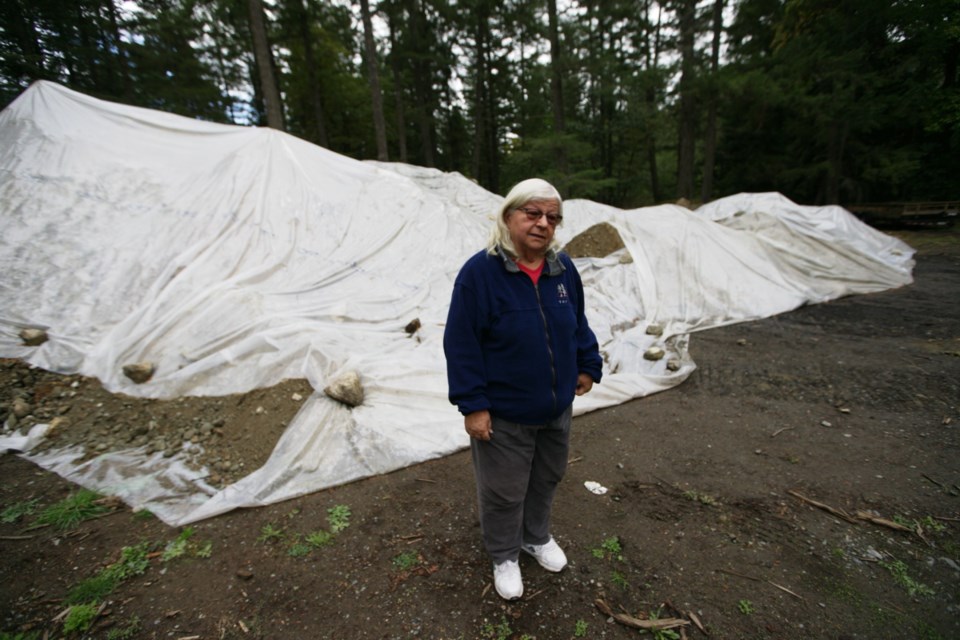A Saanich family that says it has spent $80,000 since summer dealing with soil contaminated by the previous owners is heading to court.
Cathy and Peter Blaskow said they discovered soil reeking of fuel on their five-acre property near Prospect Lake when they decided to build a new garage last year. Excavated soil was piled elsewhere on their land and Cathy estimates there could be as much as 1,600 tonnes of contaminated soil in all. Cost of soil removal or remediation has been estimated at “hundreds of thousands of dollars” by an environmental company the Blaskows hired.
The Blaskows bought the property with their daughter, her husband and their young children in 2012 because the daughter owns two horses and required a barn. Cathy Blaskow, a retired math teacher, said she is selling a rental home to help deal with remediation costs.
The couple said it cost $40,000 to dig out and pile the soil in the late summer, and they’ve nearly doubled the spending since then. The garage site was about 50 metres from the house at 240 Goward Rd. on land that did not appear to have been used.
A hazardous-waste company had piled up at least 80 tonnes of contaminated soil at the bottom of the property, Blaskow said in September.
“Remember I said it was 80 tonnes?” she said last week. “I was wrong, it was 800 tonnes, and by the time we’re finished it will be 1,600 tonnes.” That translates to 1.7 million to 3.5 million pounds. By comparison, the turf infill at B.C. Place is 800,000 pounds, a combination of silica sand and natural fibres.
Blaskow said she was hopeful the issue could be settled with the previous owner’s heirs out of court.
“I can confirm that an action has been commenced in the B.C. Supreme Court seeking recovery of the cleanup costs,” the Blaskows’ lawyer, Eric Pedersen, said in an email to the Times Colonist.
Saanich staff checked out complaints about the property twice, once in 2002 and again in 2004, but told complainants that no bylaws were contravened, a Saanich spokesperson said in September.
One of the complaints was from a neighbour who told Saanich about industrial use of the property, Blaskow said.
The Blaskows sought all written information Saanich has on the complaints and said that has turned up the name of a fuel company. Blaskow said the previous owner served as a director of the fuel company. She said that in one of the original complaints, it was indicated that up to 200 tankers a week could have been on the property, she said.
Aerial photos show that the land was “completely full of tankers” until about 2007, she said.
“It’s Saanich that really, really rots my socks,” Blaskow said. “They never really investigated it properly,” she contended. Had they done so, the problem would not have grown to its current proportions, she said.
“As far as bylaw enforcement is concerned, Saanich takes bylaw complaints very seriously and diligently investigates complaints received from citizens,” said a statement from Saanich.
“In the case of complaints received about 240 Goward Road, Saanich Bylaw Enforcement responded to two calls for service relating to this property. One was received on July 3, 2002, and was closed once compliance had been achieved. The second call was received on July 30, 2004. This complaint was investigated and then closed as no violation took place.”
Contaminated soil and site cleanup processes on private property are regulated by the province, not municipalities, and it’s up to owners to pay for the work to be done.
A water-supply test undertaken several months ago found no problem, but Blaskow has had respiratory ailments, including hospitalization for pneumonia, and her six-year-old granddaughter “is coughing nearly all the time,” she said.
The contamination appears to be from a large amount of furnace oil spilled on the ground. Blaskow is holding out hope that if the contamination level is less toxic than feared, the soil might be trucked up Island for burial, rather than having to be barged to a specialized facility on the mainland.



